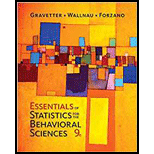
Concept explainers
What is the relationship between the F-ratio for a repeated-measures ANOVA and the F-ratio for an independent-measures ANOVA? Specifically, describe the role of individual difference in each.
Answer to Problem 1P
Repeated-measures ANOVA use fewer participants than independent-measures and ANOVA. There exist individual differences in both numerator and denominator of F-ratio of independent measure ANOVA while in case of repeated-measures design individual differences get automatically eliminated from the numerator of F-ratio but individual differences need to be computed and eliminated from the denominator of F-ratio.
Explanation of Solution
Both the F-ratio for repeated-measures ANOVA and independent-measures ANOVA are used compare the mean differences for more than two treatments but in case of repeated-measures study, same participants are used for all treatments while in case of independent-measures ANOVA, participants in each treatment are different. So, repeated-measures ANOVA uses fewer participants than independent-measures ANOVA.
Also, in F-ratio of independent measure ANOVA, there exist individual differences between treatments and within treatments because participants in each treatment are not same while in case of repeated-measures design individual differences get automatically eliminated from the numerator of F-ratio but individual differences need to be computed and eliminated from the denominator of F-ratio.
Conclusion:
Repeated-measures ANOVA use fewer participants than independent-measures and ANOVA. There exist individual differences in both numerator and denominator of F-ratio of independent measure ANOVA while in case of repeated-measures design individual differences get automatically eliminated from the numerator of F-ratio but individual differences need to be computed and eliminated from the denominator of F-ratio.
Want to see more full solutions like this?
Chapter 13 Solutions
Essentials of Statistics for The Behavioral Sciences (MindTap Course List)
- solve the question based on hw 1, 1.41arrow_forwardT1.4: Let ẞ(G) be the minimum size of a vertex cover, a(G) be the maximum size of an independent set and m(G) = |E(G)|. (i) Prove that if G is triangle free (no induced K3) then m(G) ≤ a(G)B(G). Hints - The neighborhood of a vertex in a triangle free graph must be independent; all edges have at least one end in a vertex cover. (ii) Show that all graphs of order n ≥ 3 and size m> [n2/4] contain a triangle. Hints - you may need to use either elementary calculus or the arithmetic-geometric mean inequality.arrow_forwardWe consider the one-period model studied in class as an example. Namely, we assumethat the current stock price is S0 = 10. At time T, the stock has either moved up toSt = 12 (with probability p = 0.6) or down towards St = 8 (with probability 1−p = 0.4).We consider a call option on this stock with maturity T and strike price K = 10. Theinterest rate on the money market is zero.As in class, we assume that you, as a customer, are willing to buy the call option on100 shares of stock for $120. The investor, who sold you the option, can adopt one of thefollowing strategies: Strategy 1: (seen in class) Buy 50 shares of stock and borrow $380. Strategy 2: Buy 55 shares of stock and borrow $430. Strategy 3: Buy 60 shares of stock and borrow $480. Strategy 4: Buy 40 shares of stock and borrow $280.(a) For each of strategies 2-4, describe the value of the investor’s portfolio at time 0,and at time T for each possible movement of the stock.(b) For each of strategies 2-4, does the investor have…arrow_forward
- Negate the following compound statement using De Morgans's laws.arrow_forwardNegate the following compound statement using De Morgans's laws.arrow_forwardQuestion 6: Negate the following compound statements, using De Morgan's laws. A) If Alberta was under water entirely then there should be no fossil of mammals.arrow_forward
- Negate the following compound statement using De Morgans's laws.arrow_forwardCharacterize (with proof) all connected graphs that contain no even cycles in terms oftheir blocks.arrow_forwardLet G be a connected graph that does not have P4 or C3 as an induced subgraph (i.e.,G is P4, C3 free). Prove that G is a complete bipartite grapharrow_forward
 Glencoe Algebra 1, Student Edition, 9780079039897...AlgebraISBN:9780079039897Author:CarterPublisher:McGraw Hill
Glencoe Algebra 1, Student Edition, 9780079039897...AlgebraISBN:9780079039897Author:CarterPublisher:McGraw Hill Big Ideas Math A Bridge To Success Algebra 1: Stu...AlgebraISBN:9781680331141Author:HOUGHTON MIFFLIN HARCOURTPublisher:Houghton Mifflin Harcourt
Big Ideas Math A Bridge To Success Algebra 1: Stu...AlgebraISBN:9781680331141Author:HOUGHTON MIFFLIN HARCOURTPublisher:Houghton Mifflin Harcourt Holt Mcdougal Larson Pre-algebra: Student Edition...AlgebraISBN:9780547587776Author:HOLT MCDOUGALPublisher:HOLT MCDOUGAL
Holt Mcdougal Larson Pre-algebra: Student Edition...AlgebraISBN:9780547587776Author:HOLT MCDOUGALPublisher:HOLT MCDOUGAL


